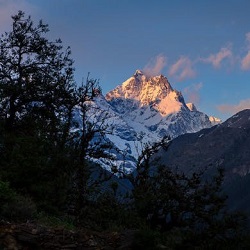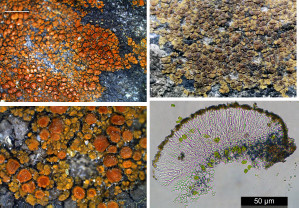SQUAMULEA UTTARKASHIANA- A NEW LICHEN IN UTTARKASHI
THE TEAM OF SCIENTISTS FROM THE NATIONAL BOTANICAL RESEARCH INSTITUTE DISCOVERED THE LICHEN Squamulea uttarkashiana AT GOVIND PASHU VIHAR IN UTTARKASHI DISTRICT OF UTTARAKHAND.
The lichen belongs to family Teloschistaceae. The family has 36 Genera, 115 Species and 4 Sub-Families. S.uttarkashiana was discovered by Dr. G.K. Mishra, Dr. S.Y. Kondr, Dr. Nayaka and Dr. Upreti. Among different Indian states, Uttarakhand shows the rich diversity of Teloschistaceae. The family in the state represents 54 genera. Among the 115 species known to India, 23 species are supposedly endemic to the country with the maximum representation of 8 in the state.
DESCRIPTION OF Squamulea uttarkashiana :
Thallus from (5–)7–12 mm across to much larger aggregations to several cm across, crustose, areolate-squamulose, dull yellowish brown or dull brownish orange-yellow, mostly numerous apothecia, very indistinctly concolorous with thallus. Areoles from very small, 0.1–0.2 mm across and very thin to 0.5–1.0(–1.5) mm across, often somewhat flattened and elongated along the thallus margin, giving an impression of a lobate thallus, to 0.7–1.0 mm long with somewhat lighter, dull yellowish edge; areole edges mostly closely attached to the substrate (not ascending!). In section thalline areoles to (100–) 170–250 µm thick, cortical layer paraplectenchymatous to 30–40(–70) µm thick, cell lumina 7–12(–17) µm long/across slightly vertically elongated; medulla throughout paraplectenchymatous; algal cells 12–19(–21) µm diam./ across, trebouxioid. Apothecia (0.15–)0.2–0.4(–0.6) mm diam., and to 0.3 mm thick in section, mostly very indistinct, 1–2 per areole, very small and concolorous with thallus, dull yellowish brown or brownish yellow, more or less immersed at first, biatorine or lecanorine to zeorine within the same thallus; thalline margin to 0.1 mm wide if apothecia lecanorine, dull yellowish brown or brownish yellow; own margin to 0.02–0.04 mm wide slightly lighter dull yellowish orange if apothecia zeorine, and disc somewhat darker, brownish orange to pale brown, sometimes to dull brownish yellow or somewhat dull pink brownish, plane and usually distinctly uplifted above the level of thalline areoles; in section lecanorine, thalline exciple to 120–150 µm wide, especially in the lower lateral portion, cortical layer to 20–30 µm thick well developed, paraplectenchymatous, cell lumina angular to 8–10 µm diam./across; true exciple to 70–80 µm thick in the uppermost lateral portion, to 15–20 µm thick in lower lateral portion, of textura globosa/paraplectenchymatous with rounded cell lumina, in basal portion to 20–30(–40) µm thick, paraplectenchymatous with rounded cell lumina to 10–13 µm diam./across; hymenium 60–70 µm high, epihymenium to 5–10 µm thick, paraphyses slightly swollen towards the tips to 3.5–4.5 µm diam.; subhymenium to 100–150 µm thick, hyaline, without oil droplets; algal zone to 100 µm thick in lateral portion, algal cells to (8–)12–21 µm diam.; asci 8-spored, to 52 × 17 µm, often with ascospores of various size within the same ascus ; ascospores widely ellipsoid, sometimes one cell is larger than the other, (8–)10–10.5 × 4.5–6 µm in water, and (9–)10–13(–14) × (5–)5.5–7(–8) µm in K, ascospores septum (1.5–)1.75–2.5(–3) µm in water and becoming much wider to (2.5–)3–6 µm in K. Conidiomata with darkish orange/reddish portion at the ostiole/tips, to 100 µm diam. and to 170 µm high; conidia widely ellipsoid or widely bacilliform (2.5–)3.2–4.0 × 1.2–1.5(–1.8) µm.
ETYMOLOGY:
It is named after type locality of this species, i.e. Uttarkashi district, of Uttarakhand, India.
ECOLOGY AND DISTRIBUTION :
Saxicolous species growing on siliceous rocks between elevations of 200–1,980 m in tropical to temperate regions of Himachal Pradesh, Rajasthan, Tamil Nadu, Uttar Pradesh, and Uttarakhand .







